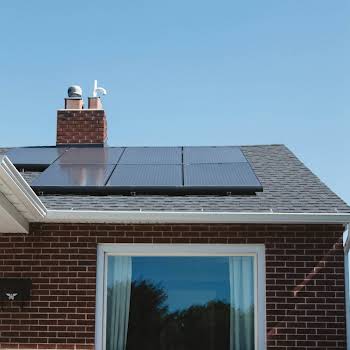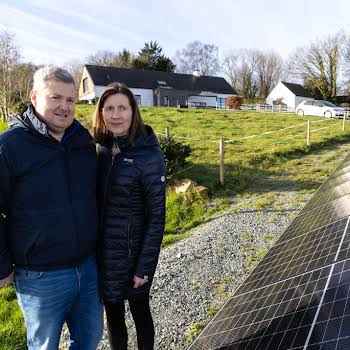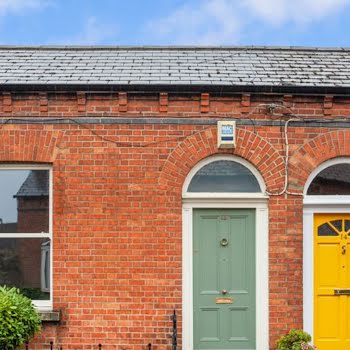
Sponsored
Lightbulb moments: How I gained control of my energy usage
Sponsored By

By IMAGE
12th Apr 2024
12th Apr 2024
Sponsored By

Sustainability journalist Jo Linehan shares how curated energy use is the next chapter in transparent consumerism and home technology.
On a rainy December day, sometime between my latest energy bill and the final dwindling days of 2023, I decided to make a change. As someone whose entire life revolves around education and sustainability, it’s a wonder it took me so long, but finally, I sent the email, downloaded the app, and prepared to enter a new phase of my energy transition: curated and transparent control of my use.
Understanding our impact
The power that runs our washing machines boils our kettles, warms our shower water, charges our smart devices, and gives us all of those lightbulb moments is one of the most vital resources we have. It’s also one of the most significant ways we, as individuals, can make a difference in our environmental footprint.
I have always advocated that consumers switch their energy supplier to a renewable provider. Not only does choosing a renewable provider help to bolster demand and, therefore, investment in clean energies on a macro scale, but it also allows us to lower our personal carbon footprint.
View this post on Instagram
Until recently, swapping energy providers and choosing a different tariff was as far as we, as consumers, could go. We still had very little information about where we were spending (or wasting) energy in our homes. Over the last few years, as energy prices soared, many of us remained in the dark about our bill costs until they arrived in the letterbox or email inbox.
Thanks to the arrival of smart meters, we now have the opportunity to better understand how we spend our energy. But harnessing that information also requires connecting with a provider committed to transparency, shedding light on our use and bills, and, most importantly, reducing it in our homes and businesses.
National climate targets
There are two main reasons why Ireland has set goals of halving greenhouse gas emissions by 2030 and becoming carbon neutral by 2050.
Fossil fuels have been our primary source of energy globally to date, but burning these fuels has resulted in significant global warming. As we face a climate crisis, scientific and political consensus is that to mitigate the worst impacts of climate change, we must move away from burning fossil fuels and find alternative energy sources.

All EU member states are obliged to adhere to the Paris Agreement, a legally binding pact between 194 parties (193 states plus the European Union) to limit global temperature increases to 1.5°C above pre-industrial levels. As an EU member state, Ireland must decarbonise and transition to clean, renewable energy.
It’s not just the environment that will benefit from this transition. In December 2021, energy prices surged globally. The COVID-19 pandemic, growing international demand, and the Russian invasion of Ukraine drove up the cost of fossil fuels globally, which trickled down to our personal energy bills.
If we can become self-sufficient from renewable sources like wind, solar, hydroelectric, hydrogen, and biofuels, we can control the price of our energy instead of being subject to global market fluctuations. In fact, Ireland has the potential to become a net provider of renewable energies, and with strategic planning, investment, and infrastructure, it could export clean energy to other nations.
This energy transition has already begun. In 2023, Wind Energy Ireland confirmed that wind farms provided a record-breaking 35 per cent of Ireland and Northern Ireland’s electricity. With more businesses and individuals valuing renewable energy’s role in our personal and planet’s future, the clean energy transition looks brighter than ever.
Making the switch
Cue my switch to Pinergy. The 100% renewable energy provider uses a combination of imported and domestically generated wind, solar, and hydroelectric power to light and heat the homes and businesses of its domestic and commercial partners.
For domestic consumers, there are three available tariffs: ‘Working from Home Time,’ tailored to those whose energy use is highest during the day; ‘Family Time’ for those who need energy in the mornings and evenings; and ‘Night Time’ for households that charge an EV overnight. Being able to tailor a tariff based on our lifestyles makes sense. We all live differently, so why should we expect one rate to suit all?
I logged on to the Pinergy website and answered some lifestyle questions, which helped me assess which rate best suited my energy usage. I work from home, so the Pinergy Lifestyle ‘Working from Home Time’ tariff was perfect for me. After I selected the tariff and provided my details, I was ready to go.
Democratising energy
That brings me back to that day in December. Over the following weeks, Christmas unfolded; we rang in the New Year and experienced storms and snow. Every day, I tracked my energy use on the Pinergy App.

Slowly, I began to change my usage habits. Because of my lowered daytime rate, I planned to wash clothes and charge devices at my desk instead of at night. I became aware of the days when I spent more energy than average and pinpointed why. Best of all, the app’s daily and monthly data allowed me to track the cost of that use in real time.
When my first bill came, there were no surprises. I had known all month what my energy use and spending had averaged. I had control, information, and, most importantly, the tools to manage my power.
For me, this means that consumers are not only supporting the transition to green energy, in line with Ireland’s national 2030 and 2050 targets, but we also personally benefit from energy savings.
New Pinergy customers typically reduce their consumption by about 8% in the first year, while a third (32%) reduce their use by at least 20% in the first year. I’m excited to be part of the Pinergy team this year. I’ll help illuminate the importance of our energy impact and educate all energy users on understanding how and where our energy is spent.
By curating our energy experience, we can take back the power. That’s the ultimate lightbulb moment.
To find out more about Pinergy Solar’s offering, visit their website today.























